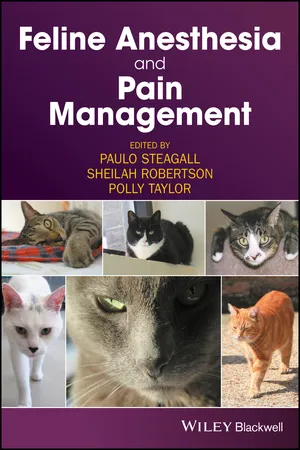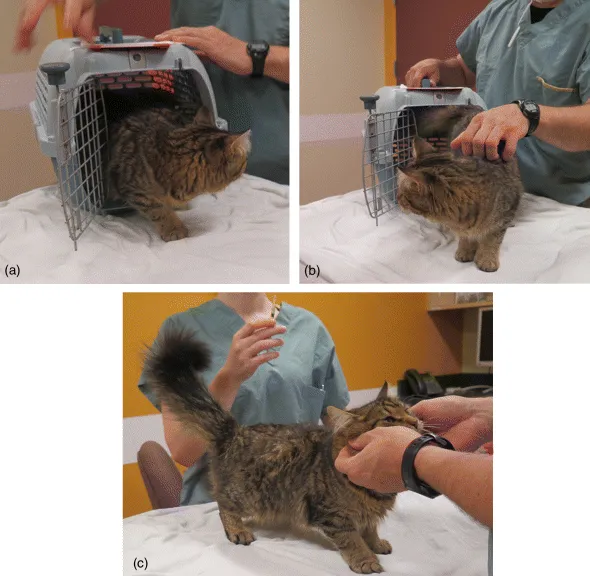
eBook - ePub
Feline Anesthesia and Pain Management
This is a test
- English
- ePUB (mobile friendly)
- Available on iOS & Android
eBook - ePub
Feline Anesthesia and Pain Management
Book details
Book preview
Table of contents
Citations
About This Book
Feline Anesthesia and Pain Management offers a definitive and practical guide to feline anesthesia and pain management.
- The only book offering detailed practical information on anesthesia and pain management in cats, one of the world's most popular pets
- World renowned author team
- Quick reference format with full color illustrations
- Offers detailed practical information on anesthesia and pain management tailored to the unique needs of cats
- Includes a team of world-renowned authors who are experts in veterinary anesthesia and analgesia
- Uses a quick reference format that makes the information easy to find and follow
- Presents full color images to illustrate concepts
Frequently asked questions
At the moment all of our mobile-responsive ePub books are available to download via the app. Most of our PDFs are also available to download and we're working on making the final remaining ones downloadable now. Learn more here.
Both plans give you full access to the library and all of Perlego’s features. The only differences are the price and subscription period: With the annual plan you’ll save around 30% compared to 12 months on the monthly plan.
We are an online textbook subscription service, where you can get access to an entire online library for less than the price of a single book per month. With over 1 million books across 1000+ topics, we’ve got you covered! Learn more here.
Look out for the read-aloud symbol on your next book to see if you can listen to it. The read-aloud tool reads text aloud for you, highlighting the text as it is being read. You can pause it, speed it up and slow it down. Learn more here.
Yes, you can access Feline Anesthesia and Pain Management by Paulo Steagall, Sheilah Robertson, Polly Taylor, Paulo Steagall, Sheilah A. Robertson, Polly Taylor in PDF and/or ePUB format, as well as other popular books in Medicine & Veterinary Medicine. We have over one million books available in our catalogue for you to explore.
Information
1
Handling, Restraint, and Preanesthetic Assessment
Graeme Doodnaught and Paulo Steagall
Université de Montréal, Saint-Hyacinthe, Canada
Key Points
- Behavioral considerations
- Handling methods and physical restraint
- Routes of drug administration
- Airway management
- Preanesthetic evaluation
- Mortality and morbidity in feline anesthesia
Introduction
The pet cat population has grown over the last few decades, as has our understanding of disease prevention and treatment in this species. Despite population growth, fewer cats visit a veterinary clinic on a regular basis when compared with dogs. Cat owners often avoid veterinary visits as transportation of the cat to the clinic may be stressful. Handling, appropriate physical examination, knowledge of behavior, and preanesthetic assessment are essential components of feline anesthesia and analgesia.
Box 1.1: Cat-friendly Techniques in Clinical Practice
Safe handling and cat-friendly practices minimize stress, fear, anxiety, and potential personnel injuries related to aggression. They are key components of veterinary care for the anesthetist and staff members.
A cat-friendly practice will provide an environment that reduces the stress of veterinary consultation and hospitalization. More information can be found at http://icatcare.org (June 24, 2017). These practices involve:
- A calm, safe, and quiet clinic with cat-designated areas or cat-only appointment times
- Gentle and efficient physical examination and treatment
- Client education on transporting the cat to and from the clinic
- Client communication about feline anesthesia and analgesia
Handling and Restraint
Each cat is unique and can exhibit a wide range of behaviors. Experienced handlers will often adapt their approach and handling technique to suit each patient. While there is no substitute for “experience”, some principles exist to aid in the restraint of most cats. The mantras “go slow to go fast” and “less is more” are commonplace. Good feline handling revolves around the premise of de-escalation, where the handler avoids potential actions that may elevate a patient's stress. De-escalation minimizes noxious visual, auditory, and olfactory stimuli that could lead to avoidance or aggressive behavior. It should be noted that the major cause of defensive or aggressive behavior is fear. Cats have limited appeasement behaviors, making it difficult to calm them once they are distressed. Thus, avoiding these behavioral triggers is critical to success.
To facilitate handling throughout life, kittens should be encouraged to interact with people, animals, and new environments between 2 and 7 weeks of age. With all ages of cats, positive reinforcement techniques (e.g. rewarding with food, play, brushing) along with behavioral therapy in difficult individuals, help to reduce the stress and anxiety associated with veterinary visits.
Most cats in a calm environment will readily explore their surroundings. Anxious or fearful individuals will tend to remain within their carriers. The cat should be handled with patience and a positive attitude throughout the physical examination. Minimal restraint is required to perform a full physical examination in most cats. Gentle touch and petting around the head and neck are generally well tolerated, and allow for minor manipulations without the need for physical restraint (Figure 1.1a, b, c). Timid or fearful individuals who choose to remain in the carrier should be allowed to do so. The top of a carrier may be removed and an examination can be performed with the cat still inside (Box 1.2).
Box 1.2: Safe Handling in Feline Practice
Consider using top-opening carriers and baskets for transporting cats into the clinic. This allows for easy handling and provides a safe and secure environment.

Figure 1.1 A cat-friendly approach in a hospital setting. (a) This cat explores the examination room and its surroundings. (b) The handler gently pets the cat to control its movement without using forcible restraint. (c) Placing the hands under the chin allows for better control of the head and neck.
It is understandable that most medical procedures in cats require some level of restraint. This makes treatments and procedures safer for both cat and handler. While immobilization is often required, the approach should still be gentle. Figure 1.2 shows common methods of control.

Figure 1.2 Restraint for common procedures in cats. (a) Most cats will tolerate gentle extension of the neck to expose the jugular veins for blood sampling. In this image the jugular vein is occluded with the cat in lateral recumbency. (b) Restraint of the forelimb for cephalic blood sampling or IV catheterization. The handler is preventing the cat from backward movement by applying gentle pressure over the cat's hind limbs. Using the same arm, the handler is extending the r...
Table of contents
- Cover
- Title Page
- Copyright
- Dedication
- Foreword
- Contributors
- Chapter 1: Handling, Restraint, and Preanesthetic Assessment
- Chapter 2: Anatomy, Physiology, and Pharmacology
- Chapter 3: Sedation and Premedication
- Chapter 4: Injectable Anesthetics and Induction of Anesthesia
- Chapter 5: Local Anesthetics and Loco-regional Techniques
- Chapter 6: Inhalation and Balanced Anesthesia
- Chapter 7: Monitoring
- Chapter 8: Fluid Therapy
- Chapter 9: Anesthetic Management of Special Conditions
- Chapter 10: Anesthetic Complications
- Chapter 11: Mechanisms of Pain
- Chapter 12: Assessment and Recognition of Acute Pain
- Chapter 13: Treatment of Acute (Adaptive) Pain
- Chapter 14: Assessment and Recognition of Chronic (Maladaptive) Pain
- Chapter 15: Treatment of Chronic (Maladaptive) Pain
- Index
- End User License Agreement